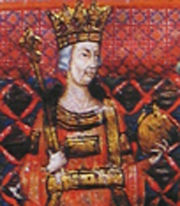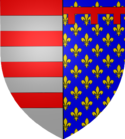- Charles II of Naples
-
Charles II 
King of Naples Reign 7 January 1285 – 5 May 1309 Predecessor Charles I Successor Robert Spouse Mary of Hungary Issue Charles Martel of Anjou
Saint Louis of Toulouse
Robert of Naples
Philip I of Taranto
Raymond Berengar
Peter Tempesta
John of Gravina
Margaret, Countess of Anjou
Blanche of Anjou
Eleanor of Anjou
Maria of AnjouHouse House of Anjou-Sicily Father Charles I of Naples Mother Beatrice of Provence Born 1254 Died 5 May 1309 (aged 55)
Naples, Kingdom of NaplesCharles II, known as "the Lame" (French le Boiteux, Italian lo Zoppo) (1254 – 5 May 1309) was King of Naples, King of Albania, Prince of Salerno, Prince of Achaea and Count of Anjou.
Contents
Biography
He was the son of Charles I of Anjou, who had conquered the Kingdom of Naples and Sicily in the 1260s. His mother was Beatrice of Provence.
During the Sicilian Vespers, he had been captured by Roger of Lauria in the naval battle at Naples in 1284. When his father died in 1285, he was still a prisoner of Peter III of Aragon.
In 1288, King Edward I of England mediated to make peace, and Charles was liberated on the condition that he was to retain Naples alone. Sicily was left to the Aragonese. Charles was also to induce his cousin Charles of Valois to renounce, for twenty thousand pounds of silver, the kingdom of Aragon, which had been given to him by Pope Martin IV to punish Peter for having invaded Sicily, but which the Valois had never effectively occupied.
Charles was then released, leaving three of his sons and sixty Provençal nobles as hostages, promising to pay 30,000 marks and to return a prisoner if the conditions were not fulfilled within three years. He went to Rieti, where the new Pope Nicholas IV immediately absolved him from all the conditions he had sworn to observe, crowned him King of Sicily in 1289, and excommunicated King Alfonso III of Aragon. Charles of Valois, in alliance with Castile, prepared to take possession of Aragon, reopening the Aragonese Crusade. Alfonso, being hard pressed, agreed to the conditions of the Treaty of Tarascon: he had to promise to withdraw the troops he had sent to help his brother James in Sicily, to renounce all rights over the island, and pay a tribute to the Holy See.
Alfonso died childless in 1291 before the treaty could be carried out, and James took possession of Aragon, leaving the government of Sicily to the third brother Frederick.
The new Pope Boniface VIII, elected in 1294 at Naples under the auspices of King Charles, mediated between the latter and James, and the dishonourable Treaty of Anagni was signed: James was to marry Charles’s daughter Bianca and was promised the investiture by the pope of Sardinia and Corsica, while he was to leave the Angevin a free hand in Sicily and even to assist him if the Sicilians resisted.
An attempt was made to bribe Frederick into consenting to this arrangement, but being backed up by his people he refused, and was afterwards crowned King of Sicily. The ensuing war was fought on land and sea but Charles, though aided by the pope, his cousin Charles of Valois and James, was unable to conquer the island, and his son the prince of Taranto was taken prisoner at the battle of La Falconara in 1299. Peace was at last made in 1302 at Caltabellotta. Charles gave up all rights to Sicily and agreed to the marriage of his daughter Eleanor and King Frederick; the treaty was ratified by the pope in 1303. Charles spent his last years quietly in Naples, which city he improved and embellished.
He died in Naples in May 1309, and was succeeded by his son Robert the Wise.
Family
In 1270, he married Maria of Hungary (c. 1257 – 25 March 1323), the daughter of Stephen V of Hungary and Elizabeth the Cuman. They had fourteen children:
- Charles Martel of Anjou, titular King of Hungary
- Margaret (1273– 31 December 1299), Countess of Anjou and Maine, married at Corbeil 16 August 1290 to Charles of Valois
- Saint Louis of Toulouse (9 February 1275, Nocera Inferiore – 19 August 1298, Chateau de Brignoles), Bishop of Toulouse
- Robert the Wise, King of Naples
- Philip I of Taranto, Prince of Achaea and Taranto, Despot of Romania, Lord of Durazzo, titular Emperor of Constantinople
- Blanche of Anjou (1280 – 14 October 1310, Barcelona), married at Villebertran 1 November 1295 James II of Aragon
- Raymond Berengar (1281–1307), Count of Provence, Prince of Piedmont and Andria
- John (1283 – aft. 16 March 1308), a priest
- Tristan (1284–bef. 1288)
- Eleanor of Anjou, (August 1289 – 9 August 1341, Monastery of St. Nicholas, Arene, Elis), married at Messina 17 May 1302 Frederick III of Sicily
- Maria of Naples (1290 – c. 1346), married at Palma de Majorca 20 September 1304 Sancho I of Majorca, married 1326 Jaime de Ejerica (1298 – April 1335)
- Peter (1291 – 29 August 1315, Battle of Montecatini), Count of Gravina
- John of Gravina (1294 – 5 April 1336, Naples), Duke of Durazzo, Prince of Achaea, and Count of Gravina, married March 1318 (div 1321) Matilda of Hainaut (29 November 1293–1336), married 14 November 1321 Agnes of Périgord (d. 1345)
- Beatrice (1295 – c. 1321), married April 1305 Azzo VIII d'Este, marchese of Ferrara etc. (d. 1308); she married secondly 1309 Bertrand III of Baux, Count of Andria (d. 1351)
Ancestry
Ancestors of Charles II of Naples 16. Louis VII of France 8. Philip II of France 17. Adèle of Champagne 4. Louis VIII of France 18. Baldwin V, Count of Hainaut 9. Isabelle of Hainaut 19. Margaret I, Countess of Flanders 2. Charles I of Naples 20. Sancho III of Castile 10. Alfonso VIII of Castile 21. Blanca of Navarre 5. Blanche of Castile 22. Henry II of England 11. Leonora of England 23. Eleanor of Aquitaine 1. Charles II of Naples 24. Alfonso II of Aragon 12. Alfonso II, Count of Provence 25. Sancha of Castile 6. Ramon Berenguer IV, Count of Provence 26. Rainou, Count of Forcalquier 13. Gersenda II of Sabran 27. Gersend of Forcalquier 3. Beatrice of Provence 28. Humbert III of Savoy 14. Thomas I of Savoy 29. Beatrice of Viennois 7. Beatrice of Savoy 30. William I of Geneva 15. Marguerite of Geneva 31. Beatrice de Valperge External links
- Armorial of the House Anjou-Sicily (French)
Regnal titles Preceded by
Charles IKing of Naples
1285–1309Succeeded by
RobertKing of Albania
1285–1301Succeeded by
Philip IPrince of Achaea
1285–1289Succeeded by
IsabellaCount of Anjou and Maine
1285–1290Succeeded by
Margaret &
Charles IIIPrinces of Achaea Champlitte family (1205–1209) Villehardouin dynasty (1209–1278) Angevin domination (1278–1386/96) Catalan-Genoese dynasty (1396–1432) ‡1386–1396: purely nominal control, interregnum of five claimantsCategories:- 1254 births
- 1309 deaths
- Roman Catholic monarchs
- Capetian House of Anjou
- Monarchs of Naples
- Albanian monarchs
- Claimant Kings of Jerusalem
- Princes of Achaea
- Counts of Anjou
- Princes of Salerno
- Counts of Provence
Wikimedia Foundation. 2010.


